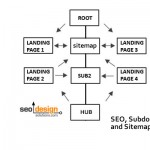SEO starts with a thorough analysis of the website to conclude which aspects of your site need optimization. Why let coding errors or poor site architecture impact rankings for the worse? With search engine algorithms changing daily, there are no guarantees that the immunity you have today (from a favorable pat on the back) will pass value tomorrow.
A typical website analysis SEO sweep would look for things like:
Link Optimization – Links leaving each page (even if pointed at other pages in the site) should all have something link worthy to communicate. A link that says “click here” is a candidate for a makeover to something more consistent with the topical theme of the site, such as click here for more information about “main keyword and qualifier” as the link instead. 50% of your link profile is up the the webmaster, make good use of internal links.
Site Architecture – does your site employ a flat or robust site architecture? If you have everything in one folder (the root folder) and are just using random or diffused titles on each page, then you could optimize your information architecture to be more conducive to a search engine friendly website. Without making the topic complex, I often use Wikipedia as an example of solid website architecture.
The use wikipedia.org/wiki/main-keyword as the optimized naming convention then, the title is the main keyword and on that page are inbound links pertaining to all manor of semantic variations of the keyword, singular, plural, analogous keywords and more importantly multiple paragraphs about the keyword.
Combine this with a few million other pages and a few million other links and now you know why Wikipedia ranks so well in search engines. The take away is clear, create consistent titles and content and link to yourself (meaning the target page) with other related pages using the main keywords on the target page.
Aside from constant refinement, the need to create performance benchmarks, asset the competition and their methods as well as prune words, links and make adjustments to code (unless your rankings are stable or improving) is just another day at the office for an SEO.
Content development – Content development is crucial (fresh relevant content is king), but you have to make sure you are not diffusing your main keyword with lots of filler as well. By publishing content frequently you are flagging the attention of search engine spiders who will visit more frequently to index your new pages.
Depending on those pages, you will either add weight to your theme and build a more robust presence or potentially sap the existing link weight and authority in your site as the real page rank becomes buoyant and moves around to find the most likely page for relevance. Eventually it will mature and transcend the new page and flow back to the rest of the site, but in the beginning, there is a gestation period where the new page is like dead weight. During this initial phase, the best thing to do is build links to the page, so it becomes an asset sooner than later (as the internal and external links normalize) and the real page rank is assigned.
Finding the right balance of links in to links out is what gives a page expression in the (SERPs) search engine result pages. Typically the ratio is 35% of the links to the homepage and 65% of the links to pages other than the home page, this is known as deep linking.
Deep links – Using deep links combined with solid site architecture, focus titles and topical content are the foundation for an authority site. This is more intermediate SEO, but a step you cannot neglect or the competition will own the SERPs, theory is nice but the distinction between word and deed and theory and action must be bridged in order to test, retest and overcome real time obstacles as they arise. SEO is truly a trial by fire, so you must constantly be ready to look for a better way to find solutions when others can only see problems.
Developing Authority – I am an advocate of building authority sites, essentially, this shifts the focus and dependency from relying on other sites to support your pages or content. An authority site can create or attract it’s own links and anchor itself as a pivotal contribution to the industry. However, it is a massive undertaking that requires a tremendous amount of nurturing to get off the ground.
But sometimes, there is just nothing really worth salvaging aside from the concept alone, in which case the evaluation may call for a transplant of a CMS (content management system) or website redesign to add some advanced functionality which prior to the solution was the source of the site being on the outs with search engines.
Salvaging what can be saved and changing what cannot – It is a difficult call, but 7 out of 10 times, a site owner may be better off scrapping an old site (deleting it) and erecting an optimized blog in its wake to organize and administer content.
Without a search engine optimization analysis, their may be phantoms lurking in your code, internal links worth saving, site architecture that with a few tweaks can purr like a finely tuned engine and an addition of 20-30 pages or topical content that can turn your site around, but without taking that first step and getting a Free SEO Website Analysis, you could be clueless about which action to take or which strategy would have the most dramatic impact on your online marketing campaign.









Great article. specially the deep links part
Good and well Analysed